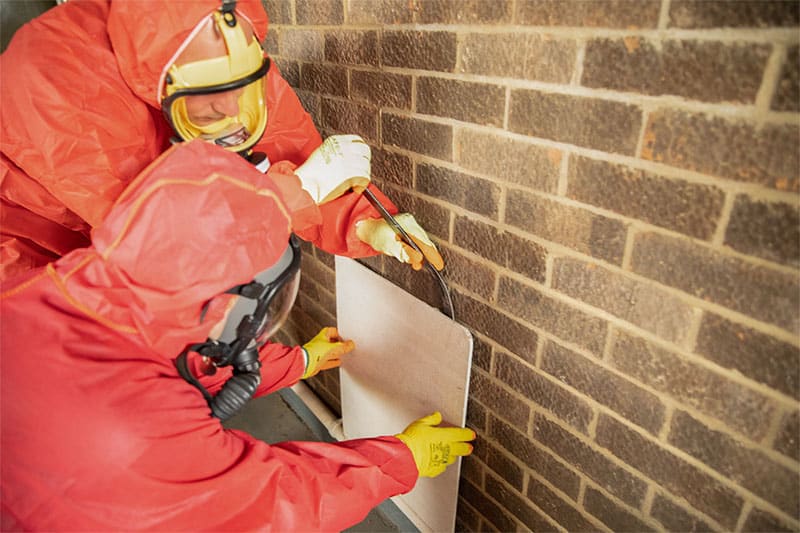Asbestos removal in UK rental properties: landlord responsibilities
Once extremely widely used in the construction sector on the basis of such factors as its physical strength, affordability, and effectiveness as an insulator, the naturally occurring silicate mineral known as asbestos has been illegal to import and use in the UK since 1999.
This ban was imposed due to what were, by then, the well-documented serious health risks that asbestos presented to those who inhaled or ingested the substance. It is known that being exposed to asbestos can heighten someone’s risk of developing potentially fatal health conditions – such as mesothelioma or asbestos-related lung cancer – in later life.
While the 1999 ban prevented asbestos from being legally used in the UK in any future construction or renovation projects, it did not bring about any automatic requirement for asbestos to be removed in any and all instances where it was already present in UK buildings.
To this day, then, if a given building was constructed or renovated during the time asbestos was in peak use in the UK – from around the 1950s up until the 1999 ban – there will be a very strong chance that the property contains asbestos.
If this is the case for a property for which you are a landlord, asbestos could be present in such places as the building’s insulation panels, pipe lagging, cement panels, or in any Artex textured ceiling coatings.
But if you are a landlord in the UK, and a building for which you are responsible dates from before the year 2000, what will your legal responsibilities be in relation to the management of asbestos?
The regulatory framework for asbestos management in the UK
The main UK legislation that landlords need to be aware of as far as asbestos in their properties is concerned, is the Control of Asbestos Regulations 2012 (CAR 2012).
This particular legislation puts in place a “duty to manage” asbestos for the owner of given non-domestic premises, or the person or organisation with clear responsibility for maintaining or repairing such premises – for example, through an explicit agreement such as a tenancy agreement.
At this point, you might be wondering how this law is relevant to you as a landlord, if the property in question is a residential one that provides a home for your tenant, rather than a “non-domestic premises”.
The short answer to that question, is that for the purposes of this legislation, “non-domestic premises” also includes the “common” areas of certain domestic premises, such as purpose-built flats or houses converted into flats. Examples of such common areas include foyers, corridors, boiler rooms, roof spaces, and garages, to name just a few.
In addition, it is important to bear in mind that under Regulation 5.6 of CAR 2012, in the event of tradespeople accessing the “residential part” of a given property, their employer has a duty to protect them from asbestos risks.
In practice, then, while there isn’t a specific legal requirement for a landlord to have an asbestos survey in place for a domestic dwelling outside of those aforementioned “common areas”, you can probably see why it would be a legally sensible course of action if your building dates from before the year 2000.
Even putting aside CAR 2012, landlords also have certain obligations under various other pieces of UK law. Those include the likes of the Landlord and Tenant Act 1985, Housing Act 2004, Homes (Fitness for Human Habitation) Act 2018, and the Environmental Protection Act 1990.
There are various elements of the laws cited above that could result in you facing legal consequences if you fail to manage asbestos in your property and adopt appropriate measures for keeping tenants safe.
Landlord responsibilities in asbestos removal
So, it is one thing to know the essential UK legislation that applies to landlords who are seeking to comply with their duties in relation to asbestos. But what specific steps will such legislation require you to take, including in the event that any asbestos discovered needs to be not only managed and monitored, but ultimately removed?
CAR 2012 provides clear information on this. Regulation 4 makes clear that the “dutyholder” for a given property – such as the landlord – needs to take reasonable steps to determine whether there are asbestos-containing materials (ACMs) in the given premises. And if ACMs are in the building, the dutyholder is obliged to find out information about its location, quantity, and condition.
There are various other duties outlined in CAR 2012 that are of relevance to landlords. These include an obligation to presume materials contain asbestos unless there is strong evidence of this not being the case, as well as a need to make, and keep up to date, a record of the location and condition of the confirmed or suspected ACMs in the building.
The dutyholder for a given premises under CAR 2012 must also assess the risk of someone being exposed to fibres from the identified materials, and they are expected to put together a plan that outlines in detail what will be done to manage the risks from these materials. This will then need to be followed by putting the plan into action, and periodically reviewing and monitoring the plan and the arrangements to act on it.
To put it another way, landlords will need to arrange for asbestos surveys and assessments to be carried out, by suitably qualified asbestos professionals, so that they can determine the above information. This information can then be used to prepare a suitable asbestos management plan.
Tenant rights and communication
Among the duties included in CAR 2012 is an obligation to provide information on the location and condition of ACMs to anyone who is liable to work on or disturb them.
With regard to the other rights that your tenants may have in relation to any ACMs that are found in the building for which you are a dutyholder, this will largely depend on the condition of those materials and the risk that they are assessed to present.
In the event, for example, that any discovered asbestos is in good condition and is not in a location where it is likely to be disturbed, you will not be under any legal obligation as a landlord to carry out any particular action on it (other than continuing to monitor it over time).
If, on the other hand, ACMs are found that show some level of damage or deterioration or that are in a location where there is a high likelihood of them being disturbed, you will need to carry out some kind of action on it – for example, encapsulating the material or removing it altogether.
Should there be a need for you to undertake such action, you will need to communicate about the situation to the tenant, so that you can arrange access to the property and for work to be done. This might, or might not, entail the tenant being rehoused while repair work is carried out.
Asbestos removal procedures
In the event that the asbestos survey you arrange to have undertaken in your property shows evidence of ACMs that have sustained minor damage, you might not need to have the material removed from the property altogether.
In this situation, you may choose to have the ACMs repaired or encapsulated, so that they cannot be easily disturbed in the future. This could be followed by putting in place arrangements to monitor the material over time.
If, however, the ACMs that you find are in poor condition or are in a location where they would be very likely to be disturbed in the future, you will have little option but to have the substance removed from the property as soon as possible.
By arranging to have this work carried out by a licensed asbestos contractor, you can help make sure the removal operation is undertaken in a safe and legally compliant way, with minimal disturbance to the tenant’s day-to-day life and use of the property.
Costs and insurance involved in asbestos management and/or removal
When you are making enquiries with various asbestos removal companies, you might be surprised by how high the prices quoted to you seem to be. Indeed, we have received questions about this so frequently here at Oracle Solutions, that we decided to put together a comprehensive guide to asbestos removal costs, to help make clear the various aspects that account for such costs.
As a landlord, you might look to take out landlord insurance that would provide protection for asbestos-related issues. If so, and you end up making a claim, the insurer may ask to see evidence that you undertook an asbestos risk assessment of the property.
This, in turn, gives you one more strong reason to keep a record of any and all risk assessments that have been carried out for your building, even if no asbestos was found. It will help demonstrate that you have done everything required under your duties to guard against the risk of asbestos in your property.
Recordkeeping and documentation
As we touched on above, recordkeeping and documentation can be extremely important for landlords who are seeking to comply with asbestos-related legislation. Indeed, it can be crucial even in ways that they might not initially be aware of.
By maintaining records of asbestos assessments and removal at a property for which you are responsible, you will be able to demonstrate to all parties that might wish to see evidence of this – such as tenants and/or local authorities – that you have complied with all asbestos management and documentation requirements.
Penalties for asbestos non-compliance
One reason why it is so important for landlords to know about the various pieces of legislation that could impact on how they manage asbestos in their properties, is because of the wide range of legal consequences that could arise for those who are non-compliant.
Under the Landlord and Tenant Act 1985, for example, if a landlord fails to proactively manage and maintain asbestos that is present in the roof or another part of the building structure, they could be at risk of their tenant suing them for breach of contract.
The Housing Act 2004, meanwhile, gives local authorities the right to take action against landlords who are not appropriately managing asbestos risks in their buildings. In accordance with this law, a landlord could be served with an Improvement Notice, a Hazard Awareness Notice, or even – in the most severe cases – a Demolition Order.
The best asbestos practices for landlords
Unless all traces of asbestos are removed altogether from the building, the responsible management of asbestos risks in a property for which you are the landlord will not be a “one-time-only” act. After all, the condition of any given ACMs could be liable to change over time.
For this reason, it will be crucial that as a landlord, you implement a programme of regular inspections and monitoring of any asbestos in your building. This will help ensure you can take suitable action if the risk situation changes.
As a landlord, you should also proactively keep yourself informed of any changes to legislation that would impact on how you are obliged to manage asbestos risks in your property.
Conclusion: taking proactive steps will help ensure safety and legal compliance
Landlords of rental properties are subject to a variety of legal obligations with regard to asbestos. This includes those contained within CAR 2012 and other legislation that does not relate so specifically to asbestos, such as the Housing Act 2004 and the Landlord and Tenant Act 1985.
Such legislation, when considered together, compels landlords to prioritise adopting measures to ensure safety and compliance. Prioritising safe and healthy living conditions for the tenants in any properties for which you are a landlord, won’t merely be good for them; it will also help ensure you avoid any adverse legal consequences that could arise from non-compliance.
Are you on the lookout for comprehensive asbestos management, surveying, and/or removal services that would enable you to fulfil the legal obligations we have outlined in this article? If so, please feel free to call the Oracle Solutions team today, or get in touch with us via email.

Written by Callum McDonald
Callum McDonald is an expert in asbestos quality management, ensuring rigorous adherence to regulations and high-quality standards in removal projects. His focus on enhancing quality and client satisfaction makes him a crucial asset in safety and compliance within the field. Callum's expertise in technical support and oversight of licensed works underscores his commitment to excellence in asbestos management, providing invaluable guidance to clients in this specialised area.


